
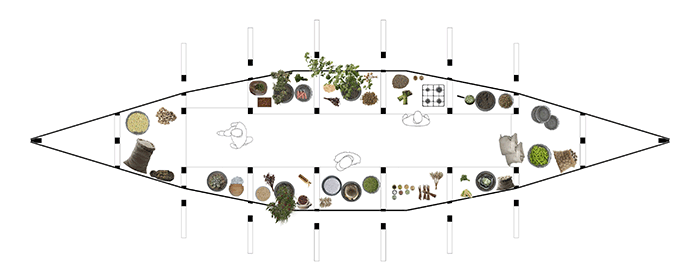
The oldest meaning of the ancient greek word for the activity of building, ktisis, is “weeding, preparation of the soil for sowing, planting“, while the meanings of ‘foundation’ and ‘construction’ are subsequent. Sowing and Construction introduce at the outset a dual function for architecture as the activity of organizing both buildings in space and, also, of open, natural spaces. By means of the present project, we seek to reintroduce into contemporary architectural practices the spaces of culture in its double meaning, of agriculture and of civilization. “People meet within culture”.
The economic crisis under way in Greece and in Europe is simultaneously a crisis of production and of employment and, overall, a crisis of human performativity within metropolitan and, indeed, any man-made environments. Beyond the bounds of the metropolis, the agricultural sector is also undergoing a crisis after the collapse of mechanized monocultures and of the European subsidies. The crisis in agriculture affects the availability and quality of nutrition. At the same time, the harsh conditions of the economic crisis in the cities turn all heads to the countryside and to the land available, which thus assumes the value of vital resource with the potential of providing employment, quality of living, alternative structuring of production and of motivating networking, the forming of communities and the development of communal living practices.
The responsibility of architecture goes beyond the bounds of the constructed edifice. It is being defined anew as a set of practices for the planning and management of land spaces. Land is tantamount to cultivation: cultivation of seeds and plants but also of civilisation, interconnections, communication and exchange. The architecture of cultivations, landscaping, the determination of performativity within given spatial fields, all these derive from the software programs which we designate as seeds and, generally, as biogenetic plant material.
The project of the ‘Ark’ attempts to point out, synaesthetically, the relation between, on the one hand, the biogenetic plant material and the seeds which are cultivated and, on the other, the kind of landscape in which we live and the way(s) in which we are metabolised. Metabolism itself is not a biological but a cultural process. The deterioration of nutrition is synonymous with the deterioration of memory and of history which, in the case of Greece, is rich both in terms of diversity and temporal continuity.
The Ark which settles on the Pavilion of Greece becomes a condenser – a bank of seeds as well as a field of exchange of both information and plant-seeding material. In addition, the Ark is a kitchen, a space where food is produced out of seeds. Eating brings people together and architecture frames this intimacy. The seeds, plants and fruit are gathered, bearing evidence to the rich Greek biodiversity. The responsibility of showcasing, preserving and restoring the biodiversity within the contemporary urban-agricultural space, is symbolically taken up by the creation and operation of the greek Ark of seeds-come-kitchen, at the 12th architecture Biennale of Venice.
Collaborators:
Ark Design: Zissis Kotionis, Phoebe Giannisi
Ark Construction: Gavrilos Michalis
Collection of Biogenetic plant material: Orestis Davias, biologist
Layout of Exhibition of Agricultural Landscape: Kostas Manolidis, architect
Video & sound installation: Yannis Isidorou, visual artist
Information layout: Alexandros Psychoulis, visual artist
Installation Consultant: Maria Papadimitriou, visual artist, responsible for the actions/workshops in the city, and the performance of catering and cultivation action
Catalogue editors: Phoebe Giannisi, Katerina Iliopoulou, Zissis Kotionis
Catalogue Design : Michalis Paparounis, publisher
Website design & development: Alexandros Psychoulis, George Kalaouzis
Communications manager, Venice project: Alexia Katsigera
Assistants: Vasia Lyri, Thaleia Melissa, Artemis Nikolopoulou, Alina Orfanou, Nikos Platsas, Michalis Softas, Anna Vasof, Niovi Zarabouka
| Sponsor: |  |
|
| Communication Sponsors: |  |
|
| Supporter: | |
|
| Financed by: |    |
|
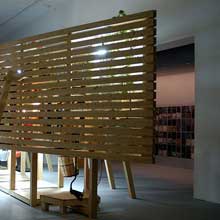 |
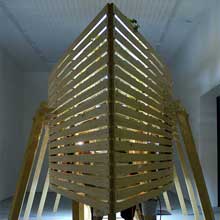 |
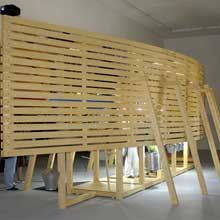 |
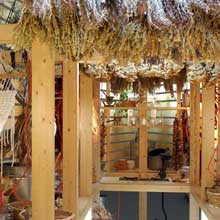 |
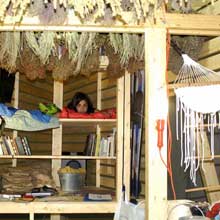 |
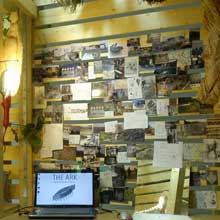 |
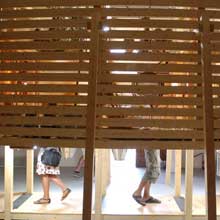 |
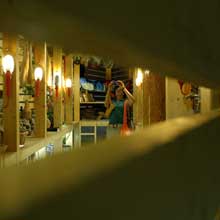 |
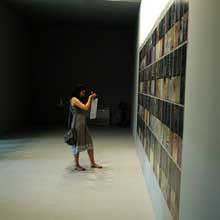 |
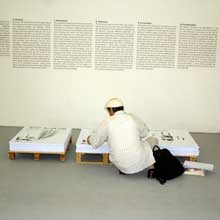 |
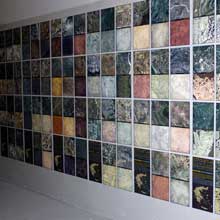 |
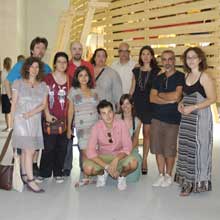 |
1. Ground Architecture is not merely the erecting of buildings. Architecture is activating a vital space for man and his actions. The landscape and the countryside are as much its field of application as buildings and the city. Space, whether open or enclosed, urban or rural, is given form by creating and inhabiting. The original actions of giving form take place in relation to the ground: laying a foundation and weeding, construction and cultivation (Heidegger, Casevitz). In the Indo-European languages, to ‘weed’, ‘cultivate’, ‘found’, ‘erect’, ‘cohabit’ derive from a common etymological root. The same word lies behind the activities which civilize space and, in parallel, create the human community (Detienne). As a result, the human ground in its totality is the field which architecture ought to manage, doing away with the demarcation between city and country and even more so today, with the new conditions of metropolitan habitats in the post-industrial period.
2. Networking In the contemporary conditions of metropolitan habitation, cultivation is reintroduced into urban spaces in snatches of sowing: urban plots on rooftops, verandahs or communal orchard-garden, and likewise with the extended grounds of the diffuse metropolitan surrounds. The interweaving of cultivations into urban space reintroduces the earth into the city creating a new regime of self-sufficiency. Simultaneously, the countryside incorporates the city through the condition of global communicational networking. The insinuation of the soil into the cityscape and of communications into the countryside does away with the demarcation between urban and rural. Inhabiting the countryside, today, does not preclude participation in global developments, thanks to electronic communication networks. It is possible for new collectivities to arise which connect small, spatially determined communities with international communities of common political agendas, ideas and practices, thus building new levels of information, circulation and exchange. (M. Hardt & A. Negri)
3. Pollination The economic crisis, ultimately, is a crisis of the model of economic development and of the continual optimization within the limited global scale. The responsibility of architecture, like that of every other cognitive practice, is situated today in the relation between optimization and restriction, production and communicational performativity. Today, the sector of agriculture and rural space in general, are defined as follows: production in the direction of sustainability and performativity in the direction of new options in re-inhabiting the countryside. Today, it is becoming possible to conceptualize a paradigm shift: in the world of bees, the production of honey is less important than pollination. The bees’ fluttering from flower to flower, occasioned by production and accumulation, is what makes possible the perennial reproduction of the world we live in. (Cohn-Bendit)
4. Distribution Just as, at the level of digital information there is an ongoing global exchange and just as, in order for knowledge to remain alive and bear fruit, it has to constantly circulate and be the object of exchange, so have seeds been objects of circulation and exchange, throughout the time of the earth and of agriculture, from Neolithic times to the present. The development and spread of agriculture was based on the transport and re-sowing of seeds on new ground. The distribution and circulation of the seed (rather than its storage in international storehouses under patriarchal control) is the only means for its safekeeping. Through its natural transport by means of the air, the sea or birds (Gunn and Dennis) and the human version of the same, through commerce, seafaring or exchange, the seed circulates, is imported, grows wild or is cultivated, modifies and adapts, remains alive, shapes space and reestablishes the food- chain.
5. Regional specificity In the seed’s genetic program is contained the entire process of its transformation. Nature as development, evolution and unfolding (Heidegger), as the being’s continual modification, all this is inscribed in the seed, with the particular environment of its cultivation as a cofactor in the evolution of its species. The seed embodies regional specificity, it encapsulates adaptation to the particular and the specific: soil, climate, geographic milieu, competition for survival with the rest of the contenders for the particular niche, vegetative or not, all these modify the plant giving the specific variety contained in the seed. Local varieties, wild or domesticated, are preserved in situ, in their natural environment and express the richness of the place and its natural and cultural history.
6. Diversity The more the importation and the beginning of the cultivation of a seed is reminiscent of a particular historical moment (e.g. Neolithic cultivations, colonization of America and distribution in Europe of the new species found etc.) the more its continued cultivation, connected to the place, shows up the selection of the plant as part of the culture superstructure of the locale. Its different uses (nutrition, cure, decoration, worship, pharmaceutics – euphoric, aphrodisiac or poisonous) are intrinsic in and expressive of the cultural specificity which a locale has historically developed. A plant’s extinction implies the disappearance not only of its particular use, but of part of the local cultural history. The domination of monocultures, the monopolies of new hybrid seeds, is equal to a diminution of freedom (Raj Patel, Vandana Shiva): it detracts from a place valuable aspects of its nutritional memory, among other kinds – testimonials preserved through collective will and practices across large spans of time.
7. Metabolism The removal of memory as the removal of cultural freedom, introduces the concomitant aspect of cultivation as civilization. Land cultivation is not civilization just by virtue of weeding and leveling and changing wild nature into land tamed by man. Land cultivation is a cultural practice also, because it relates to choices about the use of particular plant products by the community or by some members thereof. So then, a particular culture of cultivation (which is variable according to place, period, social context) is the culture of nutrition, decoration or pharmacology, and, as such, is unavoidably an expression of the cultural Imaginary that relates to the body or the spirit and their functions. The landscaping of the earth, is simultaneously a landscaping of human metabolism with specific special traits; it is a material creation and offering (of the plants and their products) which contributes to all aspects of human habitation, starting with that of feeding and ending with that of dying.
8. Hedonism The diversity of species and of their uses is important as are the ways and means of cultivation, in the reintroduction to the hedonistic approach to life (Epicure) through different parameters of time and of quality. For a large part of the human population, especially those residing in the Western world, hedonism today is connected to the quantity and the speed (Virilio) of the consumption of goods, especially lifestyle goods. The time of mandatory consumption is short. Man hurriedly guzzles bought goods to do with entertainment or personal aggrandizement. Seeds and cultivation remind us of pleasure as waiting and as duration. The annual cycle of the seasons, the cyclic alternation of periods with the activities appropriate to each, plant again human beings in the earth as one among other members of global life, of the pain and pleasure therein. The hedonism of deceleration (Kundera) throws in doubt the competitive paradigm of Western society, the financial and political model of continuous development.
9. Cohabitation Apart from war (Heraclites), friendship can also be a first principle (Empedocles). If in Darwinian evolution, antagonism is what determines the viability of a species, today a symbiotic conception of evolution has also been posited (Margulis). The means determine the manner, and biological crops where the land is allowed to lay fallow and where more than one species may be partnered in a single cultivation, can be viewed as a model of coexistence in the world of different life-forms. A companionship of plants in a single crop: the species feed in tandem, they draw nutrients from the same source, the soil, and the differences in the way they metabolize them, improve not only that same soil in which they are rooted but also the yield and form of each of them separately. It is imperative that man’s assimilation into the landscape with its live species is seen in terms of such companionship, based on mutual respect of the species (Haraway).
10. Food-together Human cohabitation entails the preparation and consumption of food. The shared meal founds the human community. The etymological meaning of com-panion-ship, is literally ‘bread-together’ (Haraway). People meet around food and the offering of food. They meet among themselves, with the rest of the living creatures and, through these, with the earth. The seed is consumed in companionship, the seed is cooked in common, the meal comes from the cultivation of the soil and it is culture in the sense of civilization and of memory. Through food, man comes in contact with the living landscape and its history. Τhe delight of food, as well as its cooking, are durable and repetitive pleasures, as is the discourse and the exchange during the shared meal. Ultimately, food, i.e. the seed, is the word and the word is the seed (Derrida). Only distribution can safeguard diversity and freedom, distribution is the only vigilance which institutes community. Distribution at an ecumenical level is the only solution for the issue of nutrition and the issue of the availability of natural resources, in general, to individuals and social groups, and across species.
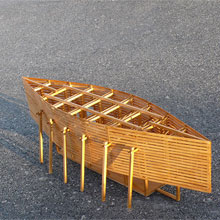 |
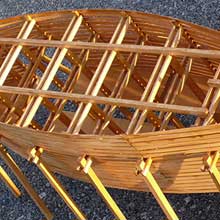 |
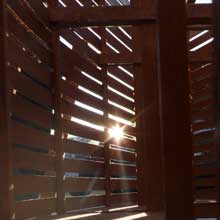 |
The concept is introduced of a movable bank of biogenetic plant material (seeds, plants, fruit) which has been collected through networking. The movable seed bank is recommended as an exemplary tool of know-how and information which can be effectively incorporated in the flexible models of metropolitan plant cultivation, inside cities and at their outskirts. A movable repository of greek biogenetic plant material is constructed, henceforth to be designated as’ the Ark’. The Ark has its own specific architecture and its program allows for the archiving and storing of seeds and the production of food.
This is a wooden construction 12 meters in length, 1.70 m. at its maximum width and 3.30m in height, which can accommodate visitors and can be dismantled and reassembled elsewhere. It is made out of planks, beams, and flat pieces of plywood. In the Ark’s interior, the seed and plant bank is complemented by the installation of a small kitchen area. The production of food from the Ark’s store/archive, allows for the exhibition space to be occupied by humans in a lively and interactive manner.
Ark and Installation design: Phoebe Giannisi, Zissis Kotionis
In the interior of the Ark is hosted the archive of biogenetic plant material (seeds, fruit, plants) in special cases (glass jars, buckets, plates et al.) The collection will be placed in the Ark according to thematic units such as the following:
- Nutritional (grains, peas and beans etc)
- Therapeutic
- Decorative
- Aphrodisiac
- Euphoric
- Deadly/Poisonous
Chief researcher and collector of seeds and plants for the Ark: Orestis Davias, biologist.

THE ARK, BENAKI MUSEUM
The Ministry of Environment, Energy and Climate Change and the Board of Trustees of the Benaki Museum invite you to the presentation of the greek participation at the 12th International Architecture Biennial of Venice.
Opening: 28/03/2011
Duration: 30/03/2011 - 22/05/2011
Wednesday, Thursday, Sunday: 10:00-18:00
Friday, Saturday: 10:00-22:00
Benaki Museum
138 Pireos Str.
Tel. 210 3453111
In addition, on 16/04/2011 a symposium is organized with lectures and activities, with the participation of Vandana Shiva (activist, philosopher) and the Peliti community.
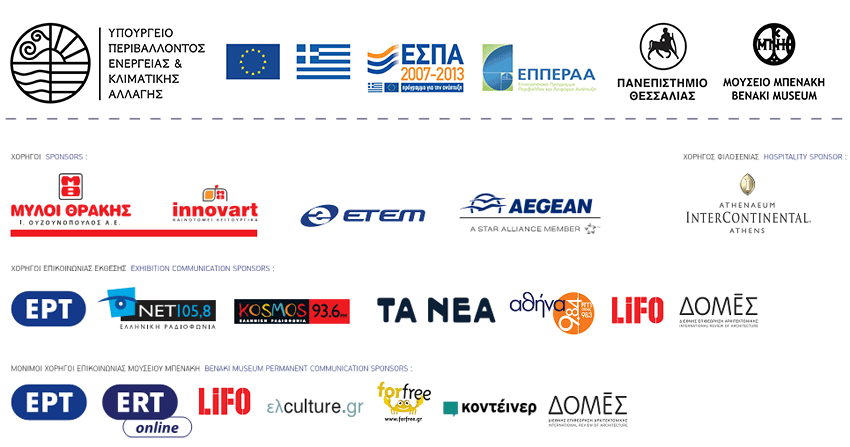
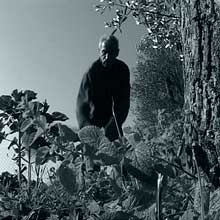 |
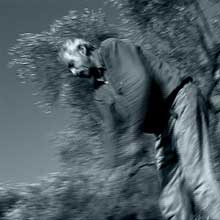 |
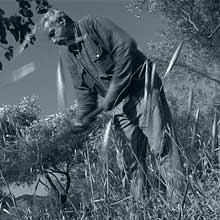 |
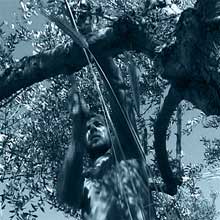 |
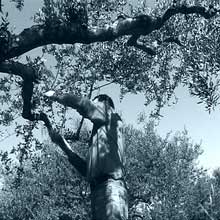 |
video stills: Giannis Isidorou |
Projection on a monitor, in the main pace of the Ark, of a video documentary on contemporary agricultural life in rural Greece and on those alternative cultures which contribute to biodiversity and to the showcasing of old biogenetic plant material. The production of the documentary necessitates filming in rural Greece, archival research and studio processing (montage etc).
Documentary production: Yannis Isidorou, video artist
Exhibition of processed photographs of agricultural landscapes of Greece. The production of the visual material has resulted from archival research of aerial photography, private collections, in situ photographs and from digital processing, printing and laying out of the images in the exhibition space.
Photographic exhibition design: Kostas Manolidis, architect
Assistants: Anna Vasof, Thaleia Melissa
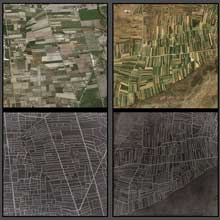 |
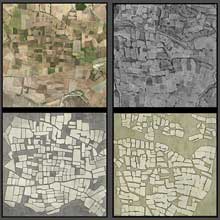 |
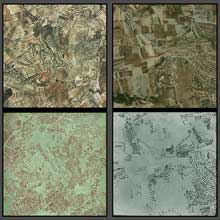 |
The architecture of cultivated land
By systematically scanning the surface of Greece via the satellite imagery of Google Earth, it is possible to locate, almost everywhere, the impact of agricultural activity on the shaping of the land. Apart from the readily recognizable cultivations of the valleys and plateaus, as one zooms closer in, one begins to identify the existence of a wider agricultural realm. Here, the zones of cultivation appear variously discontinuous because of the land’s morphology and, also, because of the gradual withdrawal from parts of the land that are less hospitable or, else, have been exhausted.
In this wider realm of mountainous and semi-mountainous regions, the agricultural landscape has been impacted to a much lesser degree by the radical transformations brought about by land rezoning and by the latest cultivating methods and infrastructures. The first distinctive characteristic from an aerial view, is the diversity and the small scale of cultivations. The scattered fields have not been reconfigured and unified and, so, remain of minimal size. The cultivated patches exist as a continuum with uncultivated zones and natural vegetation.
Geographical modulations of the ground, grooves and stream banks necessitate a piecemeal, discontinuous and irregular laying out of fields. But even where the morphology allows for fuller, more consolidated cultivation, land properties are still broken up into multiple sub-areas, usually with composite, geometrical features. The fields are laid out like fragments in a mosaic, sometimes poorly fitted together, other times tightly knit, on occasions with small barren patches in between or with the protective hedging of trees, bushes or thickets of bamboo.
Yet another steady feature of this agricultural interior is abandonment. Scanning with greater care the satellite images of places where, initially, no human shaping of the landscape is visible, it is possible to discover traces of past agricultural activity with often faint, yet discernible effects on the land. The most characteristic and exemplary such case, is the tiered landscapes in the interior of islands but also in mountainous regions of the mainland. Also, the stone fences in the drier regions which, in a lot of cases, comprised an extensive and tightly knit system of management of grazing. Less discernible and visible mainly from the air, is the case of cultivations in deforested areas of woods. Large mountainous areas of forest or bush, are dappled with vacant lots which were laboriously shorn, in order to provide additional land for cultivation. Now, these have been almost universally abandoned and are being slowly reclaimed by the forest.
Though limited, this experimental mapping of such organizational traits of agricultural fields, is very informative. It allows us to form a picture of the land’s primary civilization which every time shapes, by means of geophysical constraints and conditions, the architectural and cultural landscape. The response to the difficult and variegated morphology of greek geography has produced a variety of agricultural ecosystems and landscapes which are well due for a comeback to the forefront of developmental priorities. They offer us scarce and valuable models of humanizing natural space and putting it to productive use, models very different to the indiscriminate, homogenizing domination over the land of contemporary agricultural practices.
The catalogue of the exhibition will include texts by 25 both Greek and non-Greek writers, (architects, botanists, farmer-activists, theoreticians) on issues related to the subject matter of the exhibition . A rich collection will be created of visual material (photographs, drawings, images) on a range of themes: Archival material from Greek agriculture, an archive of stereoscopic (3D) images of seeds, archival footage of relevant material from Greek TV., processed aerial photographs of agricultural landscapes. The catalogue will be bilingual (Greek and English).
Action I: Construction of the Ark
Construction and the Ark’s journey; also, the recording of these.
Action II: Seed Collection
Participation in seed exchanges and other gatherings, visiting producers, networking.
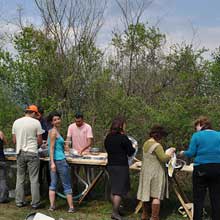 |
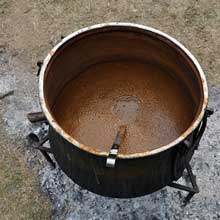 |
|
|
10th Pan-Hellenic Festival for the exchange of local seed varieties, April 10, 2010 Paranesti, Drama, Greece, organized by peliti |
||
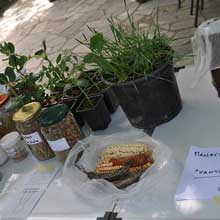 |
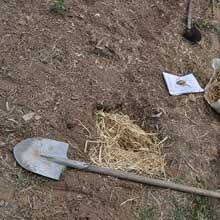 |
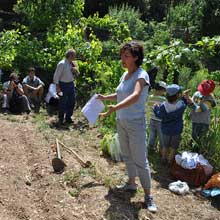 |
|
Traditional Seeds Festival and Ecological Garden, May 25, 2010 Central Square of Stayates at Pelion Mountain, organized by Aigilops |
||
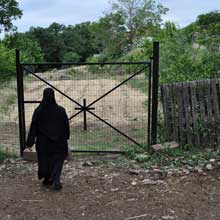 |
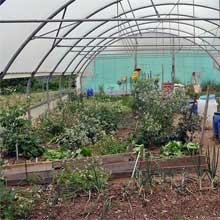 |
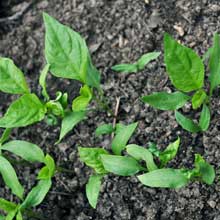 |
| Visit at the ecological farming and stock-raising places of Saint John's Monastery at Ossa, May 20, 2010 | ||
Action III+V: Joint meal and Distribution
Preparation and offering of a meal at the opening and closing, using materials from the Ark, and distribution of seeds.
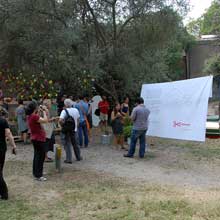 |
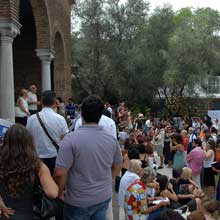 |
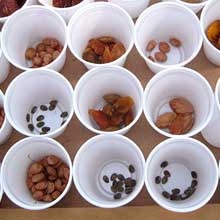 |
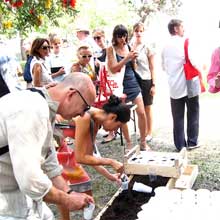 |
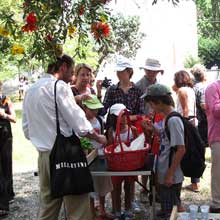 |
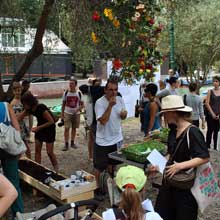 |
Action V:
Scheduled talks with time for the exchange of views, taking place at the exhibition space at regular intervals throughout the Biennale.
http://www.terramadre.info/pagine/welcome.lasso?n=en
http://www.peliti.gr
http://sporos.org/sporos
http://www.foodfirst.org/about/programs/localfood
http://www.seedbiology.de
http://www.archipelago.gr/en/ConservationActions/SeedBank/tabid/64/Default.aspx
http://forbesfarmer.blogspot.com/2009/08/final-watson-report.html
http://eurisco.ecpgr.org/about/about_eurisco.php
http://www.bioversityinternational.org/scientific_information/plants_and_animals.html
http://www.biol.uoa.gr/zoolmuseum/agricgr.htm
http://www.greenplanetmonitor.net/news/2008/11/vandana-shiva-on-seed-democracy
http://www.croptrust.org/main
http://rajpatel.org
http://www.navdanya.org/news/03nov08.htm
http://www.aegilops.gr/live
http://www.foodsovereignty.org/new
http://viacampesina.org/en
http://www.biotechwatch.gr
http://www.slowfood.com
http://www.kotionis.com
http://www.youtube.com/user/GREEKARK2010#p/f/6/puh3fyhsbR0
